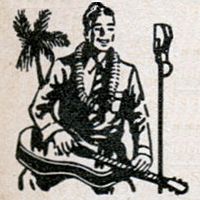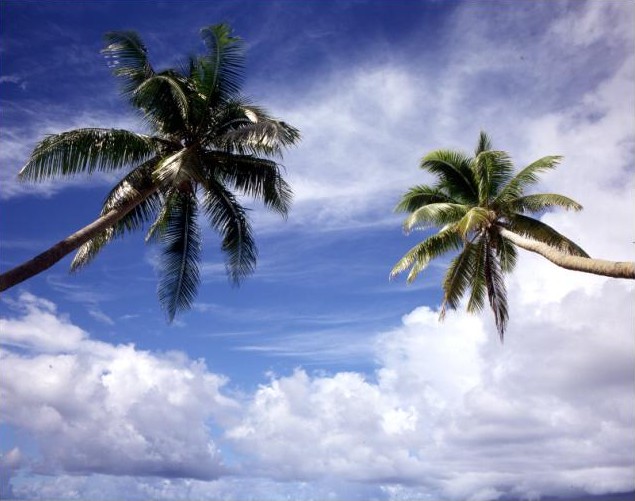Hawaiian Steel Guitar
Hawaiian Music is a
Style, Not a Guitar
 People
often ask, what's that instrument you're playing called. I tell them it is a
“lap
steel guitar” or a “pedal
steel guitar,” depending on which I take to the beach. Both are unique
and beautiful and Hawaiian music can be played equally beautiful on both
instruments.
People
often ask, what's that instrument you're playing called. I tell them it is a
“lap
steel guitar” or a “pedal
steel guitar,” depending on which I take to the beach. Both are unique
and beautiful and Hawaiian music can be played equally beautiful on both
instruments.
The first thing you need to learn
is that Hawaiian music is a style, not a guitar. Albeit, I prefer the
lap steel for Hawaiian music at the beach because it is lightweight and less
burdensome if it starts raining suddenly. Besides, I love the simplicity of
the lap steel. I've been playing less expensive lap steels lately in public
to encourage people that it doesn't requires a $1700 Jerry Byrd Frypan
guitar to sound great. My
Rogue Jersey Lightning is awesome with as good a
sustain as the Jerry Byrd Frypan (if not better).
Here's a video on YouTube of me playing the Rogue Jersey Lightning lap steel
through a Peavey Session 400 amplifier.
Here's the MP3
backing track I made with Band-in-a-Box, which you can have and share
with others.
Here's a much better MP3 version of E MAMA E that I recorded, which you
can also have and share with others. God bless and enjoy!
Here's
What A Friend We Have In Jesus that I also recorded. The track is freely
available on my “Rhythm Tracks” page.
In this article, I want to focus
on Hawaiian technique and not so much tunings, although I'm going to stick
to the C6th tuning for simplicity (and because that's what I play 95% of my
Hawaiian music on, B11th coming in 2nd). I don't claim originality for any
of these musical pieces. Most of them are from albums I've heard and worked
hard to figure them out. Please read, Playing Music
and Emotional Feelings.
By “style” I am referring to
numerous techniques that are quite popular on steel guitar giving it that
distinctive Hawaiian sound. Here are dozens of different pieces of music on
C6th tuning which I have recorded on lap steel and some tabs to guide you to
learn them on the C6th lap steel. This will help get you going and give you
a great start playing Hawaiian steel guitar.
Jerry Byrd teaches...
“Steel guitar is a Hawaiian instrument by birth and what I consider to be the
signature sound of Hawaiian music. Having undergone many changes, both
physically and musically, in the hundred-plus years of its existence, it is,
I will say without hesitation, one of the most difficult instruments to
master.” —Jerry Byrd, “It Was A Trip On
Wings Of Music,” by Jerry Byrd (1920-2005); © 2003, p. 110.
I have tried to be helpful by
indicating which fingers I used to pick the notes, placing a letter after
each number. Of course, the number represents the fret upon which to place
the bar on the designated string.
T=thumb
F=forefinger (or
index finger)
M=middle finger
-
Hawaiian Piece 01 |
Hawaiian Piece 01b |
Hawaiian Piece 01c |
Hawaiian Piece 01d
E___8M___________12M______12~~10M___8~M___________________________
C_______9T~~~12______12T__________________________________________
A________________________________________7T_______________________
G_________________________________________________________________
E_________________________________________________________________
C#___Note: on 01b version I start on 9th fret instead of 8th._____
-
Hawaiian Piece 02 (to chime
the notes at fret 17, gently place your palm across the strings and rake
your thumb pick across strings 5 through 2 and then immediately lift
your palm off the strings)
E_________________________________________________________________
C____5M____*5~~~17____Thumb rakes across strings 5 and 4__________
A____5F____*5~~~17________________________________________________
G____5T____*5~~~17________________________________________________
E____5T____*5~~~17________________________________________________
C#_*chime across strings using palm harmonics at the 17th fret.___
-
Hawaiian Piece 03
E_________________________________________________________________
C____5~~~17_______________________________________________________
A____5~~~17_______________________________________________________
G____5~~~17_______________________________________________________
E____5~~~17_______________________________________________________
C#________________________________________________________________
-
Hawaiian Piece 04
E____*5__________________3M__4M__~5M______________________________
C_____*5_________4M__5M___________________________________________
A______*5____5F___________________________________________________
G_________5(thumb plays__________~5T______________________________
E___________(this note)___________________________________________
C#__*Back-rake across the first 3 strings using your forefinger___
-
Hawaiian Piece 05
E___*5F___________________________________________________________
C____*5F__________________________________________________________
A_____*5F_________________________________________________________
G________5T (note that thumb plays this note)_____________________
E_________________________________________________________________
C#___*same as above, back-rake with forefinger toward you.________
-
Hawaiian Piece 06
E______*3~0~3~0M_____________0~1M____1M___________________________
C________________________0F__________0F___________________________
A___________________0~1F_____________0T___________________________
G_______________0T________________________________________________
E_________________________________________________________________
C#_*string one is only picked once at 3rd fret, then bar bounced__
-
Hawaiian Piece 07
E_________________________________________________________________
C____*5~~~17__________These are palm harmonics.___________________
A____*5~~~17______________________________________________________
G____*5~~~17__________Notice that you are sliding up one octave.__
E____*5~~~17______________________________________________________
C#__*Rake across strings while gently lifting palm off 17th fret._
-
Hawaiian Piece 08 (thumb is
used on string 5, and middle finger on string 2)
E___Below you are blocking the 5th string with the thumb pick.____
C_____4~~6___6~~8___8~~9___9~~11____11~9___9~~8___8~~6___6~~4__4__
A_________________________________________________________________
G_________________________________________________________________
E___4______5______7______9_______11______9______7______5_______4__
C#________This technique is called pick blocking._________________
-
Hawaiian Piece 09 (thumb is
used on string 4, and middle finger on string 1)
E____4~~5___5~~7___7~~9___9~~11___11~~9___9~~7___7~~5___5~~4____5_
C______________________________________________________________5__
A_________________________________________________________________
G__4______6______8______9______11_______9______8______6_______5___
E_________________________________________________________________
C#___Same exact technique as above, but on strings 1 and 4________
-
Hawaiian Piece 10 (thumb is
used on string 4, and middle finger on string 1)
E___8________6________5_________3______1__________________________
C_________________________________________________________________
A__________________________________________These are advanced_____
G_____9~8~7____7~6~5_____5~4~3____3~2______techniques, but you____
E__________________________________________need to know them so___
C#___This is a great scale exercise._______you can work on them.__
-
Hawaiian Piece 11
E_________________________________________________________________
C___9~M___________________4M___5M_________________________________
A_______8T_____5F_____3F__________________________________________
G___________5T_____3T__________5F_________________________________
E______________________________5T_________________________________
C#________________________________________________________________
-
Hawaiian Piece 12 |
Hawaiian Piece 12b
E________5~~3M____________________________________________________
C_______________4~~2F_____________________________________________
A_____________________1T__2T__3T__________________________________
G___4~5T__________________________________________________________
E_________________________________________________________________
C#________________________________________________________________
-
Hawaiian Piece 13
E____10M__9~8M____________________________________________________
C______________8F_________________________________________________
A_________________7T__6T__5T___4F_________________________________
G_________________________________5T______________________________
E_________________________________________________________________
C#________________________________________________________________
-
Hawaiian Piece 14 |
Hawaiian Piece 14b
E______~6~5M_______________________On this piece fingering is_____
C_________________~7~6M___5M_______very important to sound right._
A_________________________________________________________________
G____5T______5F___________5F_________T=thumb___M=middle finger____
E_______________6T________5T___________F=fore (index) finger______
C#________________________________________________________________
-
Hawaiian Piece 15 |
Hawaiian Piece 15b (same as
first, but on 10th fret)
E____5~~~___5~~~____5___5_________________________________________
C___________________5___5_________________________________________
A___*5~~7___7~~5__________________________________________________
G___________________5___4_________________________________________
E_*reverse bar slant and then slant back down after picking again_
C#________________________________________________________________
-
Hawaiian Piece 16
E___________5M______8M___________10M___10M___10M___10M____________
C_____________6F______9F___________________________10F____________
A_______________6T______9T___~10~~~T___9T_________________________
G___4T__5T___________________________________10T___9T_____________
E_________________________________________________________________
C#________________________________________________________________
-
Hawaiian Piece 17
E___________________________________________________3_3_4_5_______
C______________4M_4M~5M~_____________________4__~5__3_3_4_5__5____
A__3M_______3M___________3F~___2F_3~2~3F___3F___~5___________5____
G______2~3F_________________2T__________~3T_____~5__3_3_4_5__5____
E____3T_________________________________________~5___________5____
C#________________________________________________________________
-
Hawaiian Piece 18
E_________________________________________________________________
C_______________________4M___5M___________________________________
A___2F__3~2~3F______3F_______5F___________________________________
G______________~3T___________5T___________________________________
E____________________________5T___________________________________
C#________________________________________________________________
-
Hawaiian Piece 19 (clips 19
through 33 all recorded with $79 Rogue lap steel. Listen to musical
pieces 34 and 35 to hear a 24 1/2" long-scale Jerry Byrd aluminum Frypan
and the rich difference in tone. The Jerry Byrd Frypan is much nicer,
having a beautiful tone. It's the original stock factory pickup in the
Byrd Frypan. Plus, the $79 lap steels fall apart after a few years and
don't stay in tune as well. You get what you pay for. Still, you can't
beat $79 for what you get, with a stand and legs. By the way,
consider a quality 'Deluxe 34' laptop stand for your lap steel if you'd
like one.)
E________________~10__9__8________10____*I'm recording clips 19___
C_______7__9~________________10__________through 33 with my Rogue_
A____8________8______________10__________$79 lap steel, through___
G____________________________10___10_____a G5222 Gretsch amp &____
E____________________________10__________a BOSS '63 Reverb pedal._
C#________________________________________________________________
-
Hawaiian Piece 20
E_______________3__4__5_______________~10__9__8___________________
C_________4__5________________7__9~______________10_______________
A_______5__________________8________8____________10_______________
G_____5_______________5__________________________10_______________
E________________________________________________10_______________
C#________________________________________________________________
-
Hawaiian Piece 21 |
Hawaiian Piece 21b
E_______________________7_________________________________________
C________12______7_________5_______All natural harmonics__________
A______12______7_____5____________________________________________
G___*12______7____________________________________________________
E_________________________________________________________________
C#_*use left hand pinky finger to chime all of these (no bar)_____
-
Hawaiian Piece 22
E____4~~5T_________________________________________________________
C____4~~5T___________6M~5__________________________________________
A____4~~5T_________6M_~~5___*5~~17_________________________________
G____4~~5T_______6F_~~~~5____5~~17_________________________________
E____4~~5T___5~6T_~~~~~~5____5~~17_________________________________
C#_________________________________*palm harmonics_________________
-
Hawaiian Piece 23 |
Hawaiian Piece 23b (same as
first, but then I raise the bar to fret 5)
E_________________________________________________________________
C___*4M~~________*I begin my downward bar slide at about _________
A____4F~~_________fret number 10. I also back off the volume______
G____4T~~_________and then raise it as I'm sliding down into______
E____4T~~_________home base at fret number 4._____________________
C#________________________________________________________________
-
Hawaiian Piece 24
E__________*Thumb rakes across all of these.______________________
C__*~6___~6___5___________________________________________________
A___~6___~6___5___________________________________________________
G___~6___~6___5___________________________________________________
E___~6___~6___5___________________________________________________
C#________________________________________________________________
-
Hawaiian Piece 25 (The
following musical piece works very nicely in many Hawaiian songs; such
as, "Beyond the Reef" and "Farewell My Tani")
E_________________________________________________________________
C___________6~~9~~12~11~10________________________________________
A______5~6~~~~~9~~12~11~10________________________________________
G___5_____________________________________________________________
E_________________________________________________________________
C#________________________________________________________________
-
Hawaiian Piece 26
E__________________8___~10_____8__________________________________
C____________7~8____________9_____________________________________
A_______5~7_______________________________________________________
G____5____________________________________________________________
E_________________________________________________________________
C#________________________________________________________________
-
Hawaiian Piece 27
E_________________8~10______8_____________________________________
C____________7~8________9______8__________________________________
A_______5~7________________________7___6___5______________________
G____5____________________________________________________________
E_________________________________________________________________
C#________________________________________________________________
-
Hawaiian Piece 28
E_________________8~~12~11~10~9~8_________________________________
C____________7~8~~~~~12~11~10~9~8_________________________________
A_______5~7_______________________________________________________
G____5____________________________________________________________
E_________________________________________________________________
C#________________________________________________________________
-
Hawaiian Piece 29
E___*13M_____________________________Note: For the second part____
C_____13F___15M___13M___12M__________of the clip, I'm simply______
A____________15F___13F___12F_________alternating the same fingers_
G____________________________________shown (Mexican style)._______
E_________________________________________________________________
C#___*I'm simply picking the strings backwards, separately._______
-
Hawaiian Piece 30
E___0M___0___0___0___0___0___0____________________________________
C___2F___2___1___1___0___0___1____________________________________
A___2T___2___1___1___0___0___1____________________________________
G_________________________________________________________________
E_____Note: This piece is common in Hawaiian intros, songs________
C#____like 'Analani E'.___________________________________________
-
Hawaiian Piece 31
E____0M____0____0_________________________________________________
C____11F___10___9_________________________________________________
A____11T___10___9_________________________________________________
G_________________________________________________________________
E______Note: This is used in 'Panhandle Rag' (not Hawaiian song)__
C#_____but it's something that's good to learn.___________________
-
Hawaiian Piece 32
E____0M____0_____0____0____0______________________________________
C____0F____0_____0____0____0______________________________________
A____10T___12___~13___12___10_____________________________________
G_________________________________________________________________
E____Note: This is more of a Western Swing piece, but I want______
C#___you to learn about working with open strings.________________
-
Hawaiian Piece 33
E_____0M__________________________________________________________
C____~4T___0F_____________________________________________________
A_________~3T___0F________________________________________________
G______________~2T___0F___________________________________________
E___________________~3T___________________________________________
C#____This is another interesting piece you should know.__________
-
Hawaiian Piece 34 (I used a
Jerry Byrd 24 1/2" long scale Frypan to record the musical pieces below
for 34 and 35. You you can hear the rich tone in comparison to the $79
Rogue steel used from pieces 19-33)
E____5~3M_________________________________________________________
C_________3F______________________________________________________
A____________3T__2T_______________________________________________
G___________________3T__2T________________________________________
E_________________________________________________________________
C#________________________________________________________________
-
Hawaiian Piece 35
E____5~3M______________________________________~6M________________
C_________3F____________________________5F_________5F~____________
A____________3T__2T_________3F__4T__5T_____5T_________4T__________
G___________________3T__2T________________________________________
E_________________________________________________________________
C#________________________________________________________________
-
Hawaiian Piece 37 (this is
part of Herb Remington's instrumental song, SWEETNIN.' Try it
with an
A6th rhythm track or
a C6th
Rhythm Track (uses real instruments in track).
Hear me play the song
using an older BB track, or
watch on YouTube (I used A6th in the video). The A6th is the same as
the C6th with a high G, just 1 1/2 tones lower in pitch. Herb Remington
popularized this A6th tuning. I like the A6th because the lower pitched
strings have a richer tone to them. I slowed the tempo of the song down
a bit from Herb's original to give it more of a swing feel. Here's part
of the tabs below. These are good muting and chiming techniques to
learn. This is a great song (see
bottom half of page) to learn and play...
E______________0_______7_7___5_5__________________________________
C____0_0___2___0___7___7_7___5_5___0_0___2__0_____________________
A____0_0___2_______7_______________0_0___2__0_____________________
G_________________________________________________________________
E_____All of the above notes are played by muting the strings_____
C#____with the right hand placed just before the bridge.__________
E___*12___*7__*5__*7_________repeat above section again.__________
C___*12___*7__*5__*7______________________________________________
A_________________________________________________________________
G___*These notes are all chimed using palm harmonics. These are___
E___natural harmonics, meaning that you don't use the bar to play_
C#__them. Place your pinky across the two strings and chime.______
The following pieces (38-43) were
recorded using an 8 string CANOPUS brand guitar tuned to standard
C6th with an added Bb (dominant 7th chord).
In this first piece, I do some
thumping (as I call it) exercises on the bottom string tuned to a low C. I
use two different techniques so you can here what they both sound like. In
the first technique, I simply use the thumb pick to block the string after
picking it, and then move down to the next fret. I don't skip any frets,
thumping each fret as I descend down to fret three. In the second technique,
I actually raise the bar off the string just a little bit each time after
picking the string, to give it that chicken-pickin quality.
-
Hawaiian Piece 38
E___________*To learn this, simply start slow and accurate._______
C______________*Accuracy is more important than speed.____________
A______*As you get the hang of it, your speed will increase.______
G_____*It's great practice to move your bar one fret at a time____
E______up and down the neck. Go up an octave and then down._______
C_________________________________________________________________
Bb________________________________________________________________
C____10___10__9__8__7__6__5__4__3_________________________________
E__*Notice below that I silence the 9th string while sliding up.__
B__________3~~14~15_______________________________________________
A_________3~~~14~15____*Just touch the string with your thumb_____
G________3~~~~14~15_____pick while sliding to silence it._________
E_______3~~~~~14~15_______________________________________________
C______3~~~~~~14~15_______________________________________________
Bb___*3~~~_____*I block the 9th string because it doesn't sound___
C____3~~~~~~~~14~15_____good in an octave slide.__________________
-
Hawaiian Piece 39 (I use the
preceding technique in the song, “Beyond The Reef,” just to give you an
idea how it is used. I tabbed out some of the parts below)...
E______________________________________|_____________________3____
C_____8________________________________|___*10~~12~~10___8___3____
A_____8_________________________11~10__|___*10~~11~~10___8________
G_____8________________________11~~10__|_____________________3____
E_____8___8___9___10__________11~~~10__|____10~~~~~~~~___8________
C_________8___9___10_________11~~~~10__|__________________________
Bb________8___9___10________11~~~~~10__|___*forward bar slant_____
C______________________10~11~~~~~~~10__|__________________________
-
Hawaiian Piece 40 (The
following is the A13th tuning. I recorded this piece twice,
this one doesn't hold the bass
note at the end quite as much. Notice the G note on the seventh
string. Also, notice that string 2 is lowered to a B note instead of the
normal C. This is not a standard tuning, just a variation that you
should be aware of for particular songs, like “Unforgettable.” Jules Ah
See used this A13 piece below on “Beyond The Reef” with Barney Isaacs,
on the album “Hawaiian Shores.”
E___Click Here for complete tabs and history____________
B___< NOTICE B NOTE INSTEAD OF C__________________________________
A_________________________________________________________________
G_________________________________________________________________
E_________________________________________________________________
C_________________________________________________________________
G___< NOTICE G NOTE INSTEAD OF Bb_________________________________
C_________________________________________________________________
-
Hawaiian Piece 41 (this piece
uses some of the things I just shared with you. I tabbed out the single
string solo for you. I played the
piece a little slower here. You can hear the descending note pattern
(bass thumping) again as I taught you in Hawaiian Piece 38)...
E__________10~~13___11~____11~___________8~9__8__7__|_______________________
C________10___________________10______9_____________|_______________________
A___9~10______________10________10~9________________|_________________10____
G___________________________________________________|________________10_____
E___________________________________________________|__8__9__10_____10______
C___________________________________________________|__8__9__10____10_______
Bb__________________________________________________|__8__9__10___10________
C___________________________________________________|____________10_________
-
Hawaiian Piece 42 (this is
very Hawaiian sounding. I learned this from George De Fretes song,
“Beyond The Reef.”
E_____________12_____~13__12__12~10_______________________________
C_______________________________________________11~12__12__*12____
A___________________________________10_______10___________________
G_____________12__12____________________9~10___________12_________
E____11__12____________________________________________12_________
C____11__12_______________________________________________________
Bb______________*Palm harmonic (also called a chime)______________
C_________________________________________________________________
-
Hawaiian Piece 43 (a variation
of “Beyond The Reef.” Notice especially the large chord voicings and
then the end chord. I like the sound of the very last chord, dropping
from the 4th fret to the 3rd)...
E___________10__9__8______________________________________________
C___9__10___________________10____8___7___6~5___3_________________
A___9__10___10__9__8_______10~____8_________________4~~3__________
G_________________________10~~____________________________________
E________________________10~~~____8___6___5~4___3___4~~3__________
C___________10__9__8____10~~~~______________________4~~3__________
Bb_____________________10~~~~~____________________________________
C_____________________10~~~~~~____________________________________
-
Hawaiian Piece 44 (you can use
the following two licks in tons of songs. It's a great technique to
learn.)
E_________________5___6___*7~8____________________________________
C______________5______________*8__________________________________
A_________5~6___________________*7___6___5________________________
G___5__5__________________________________________________________
E_________________________________________________________________
C______*triples (three notes played in duration of one note)______
-
Hawaiian Piece 45
E____________________5___6___*7~8_________________________________
C_________________6_______________*8______________________________
A___________5~6______________________*7___6___5___________________
G____~5__5________________________________________________________
E_________________________________________________________________
C_____*triples (three notes played in duration of one note)_______
-
Hawaiian Piece
46 (here's 4 beautiful clips that only Leonard T. Zinn could play so
beautiful. Watch video)
E________5___________________3________5___5_______________________
C___________7___________________4__5__5___5_______________________
A_______________7~6_______________________________________________
G___4__5______________5~4__3__________5___5_______________________
E_________________________________________________________________
C_________________________________________________________________
-
Hawaiian Piece
47 (Leonard T. Zinn. Watch video)
E__________3______________________________________________________
C_____________4~_________4~~5___5_________________________________
A_____________________3___________________________________________
G____2__3_________3_____________5_________________________________
E___________________________5___5_________________________________
C_________________________________________________________________
-
Hawaiian Piece
48 (Leonard T. Zinn. Watch video)
E______________~11___10~9~8______________10_____________________________
C_____________________________10_______10____~13_____11__12__12~10___9__
A_______9~~10____________________________________13__11__12__12~10___9__
G___9________________10~9~8___10___9_10_________________________________
E_____________________________10_____________________________________8__
C_______________________________________________________________________
-
Hawaiian Piece
49 (Leonard T. Zinn. Watch video).
I added a variation below. As a general rule, don't forget to use
vibrato on any note that pauses when playing steel guitar. I've had
people come up to me and say they really like the vibrato. This is a
classic Hawaiian piece...
E__________5__3________________________~5~~4__3___________________
C________________4~~2_______4~~~__5____~5~~4__3___________________
A_______________________1_________5_______________________________
G____4__5_________________________5_______________________________
E______________________________5__5_______________________________
C_________________________________________________________________
E__________5~3_________________3_________5___5____________________
C_______________4~3_______________4~5________5____________________
A_____________________3~2__1______________________________________
G____4__5____________________________________5____________________
E_________________________________________________________________
C_________________________________________________________________
-
Hawaiian Piece 50
E___1_______1~~~~~~~6~~~~~~~~~~5~~~17_____________________________
C____1_______1~~~~~~~6~~~~~~~~5~~~~17_____________________________
A_____1_______1~~~~~~~6~~~~~~5~~~~~17_____________________________
G______1_______1~~~~~~~6~~~~5~~~~~~17_____________________________
E_______1_______1~~~~~~~6~~5~~~~~~~17_____________________________
C_________________________________________________________________
-
Hawaiian Piece 51 (I recorded
this clip so you could learn this important technique. It's not
difficult if you get the technique correct. The triplets begin with the
thumb. That's the key. Focus on that first note with the thumb, and then
the other two notes will follow. I sometimes use my forefinger, and at
other times my middle finger. Use what feels most comfortable and
NATURAL to you.)
E__*This is a popular Hawaiian technique which Bud Tutmarc mastered.__
C_____________________________________________________________________
A____5M______*5M______________________________________________________
G_________*5T___*5T___4T______________________________________________
E_____________________________________________________________________
C__*triples (three notes played in duration of one note)______________
-
Hawaiian Piece 52
E__________________________________________________________11__10___
C___________________________________________________11~~___11__10___
A______3______6_______9_______12___________________11~~~___11__10___
G________3_____6_______9________12____12~11_______11~~~~____________
E_____3______6_______9_______12______12~~11______11~~~~~____________
C_______________________________________________11~~~~~~____________
Bb___3______6_______9_______12______12~~~11____11~~~~~~~____________
C_____________________________________________11~~~~~~~~____________
-
Hawaiian Piece 53
E_________________________________________________________________
C_________________________________________________________________
A_________________________________________________________________
G_________________________________________________________________
E_________________________________________________________________
C_________________________________________________________________
A Kayton Roberts
Hawaiian Piece
Here's
a great Hawaiian lick by
Kayton Roberts at 1:29 in this nice video. I tabbed the piece below.
Kayton is simply following the chords, but he's playing the notes
separately. So you can play other chords like this too, which is important
to obtain that cool Hawaiian sound...
E_________________________________________________________________
C_________________________________________________________________
A________7~______5~_______4~______________________________________
G_________________________________________________________________
E_________________________________________________________________
C____8_______6________4________2__________________________________
Here's some Hawaiian techniques to
incorporate into your playing from Jerry Byrd's timeless song
Lovely Hula Hands ...
-
Lovely Hula Hands Clip 01
- Here Jerry is moving the bar back-n-forth on string one between frets
10 and 8, which sounds nice.
You
can watch me play the song here.
-
Lovely Hula Hands Clip 02
- Dropping down from one note to another. There are many different ways
to use this technique, jumping up or dropping down a note or many notes.
-
Lovely Hula Hands Clip 03
- The “p-tah” (playing 2 note as if they were one) which is done by
picking the 7th fret on the 3rd string with the thumb pick, and then
immediately after you begin sliding up, change to string 1 and pick it
at the 8th fret, sliding up into the 10th fret. If you listen to the
following clip very closely, you'll hear the bar leaving the 7th fret
and then immediately Jerry picks the 1st string and slides up into the
10th fret on string one. I've actually
slowed the piece down
considerably in this clip, so you can hear exactly what Jerry is
doing. The goal is to make it sound seamless, which takes much practice
to get it to sound natural and Hawaiian. It's one of those things that
sound better by just doing it instead of trying to explain it. Also,
Jerry's Bakelite Rickenbacher and old amp had a loud-horn kind of tone
to it, which is desired for Hawaiian. The piece would be tabbed
follows...
E___________________~10___8~______________________________________
C_____________________________7~__________________________________
A_________5__6__*7~_______________________________________________
G___5__5_________________________5________________________________
E__________________*p-tah going from 7th fret to 10th fret________
C#________________________________________________________________
-
Lovely Hula Hands Clip 04
- Here's some beautiful Hawaiian style playing. You'll hear another
drop-down at the end. Notice how the notes flow and sound progressive.
This only comes with practice. Jerry has an arrangement that he worked
up, knowing what note comes next, so he can focus on quality of the tone
instead of what to play next. Once you learn a song very well, and also
know the scales within that chord, then you can increase the beauty of
the song and your skills.
-
Lovely Hula Hands Clip 05
- Minor chords used in the song.
-
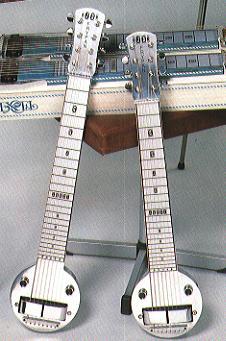 Lovely
Hula Hands Clip 06
- Here you can learn how harmonics are used in a Hawaiian song. I'm
beginning to make it a goal to use harmonics in almost every song, except the
faster ones like Sand. If you don't plan to use harmonics on purpose, then
you'll avoid them by habit and they won't become a natural part of your playing.
What really got me into playing harmonics was listening to my own recordings and
how pretty the harmonics sound. So I decided to use them more. Listen to your
own playing (record it and then listen while drinking a cold iced tea and
resting) to see what's missing, or what sounds good. Play what you hear, and
hear what you play. It's an important learning tool.
Lovely
Hula Hands Clip 06
- Here you can learn how harmonics are used in a Hawaiian song. I'm
beginning to make it a goal to use harmonics in almost every song, except the
faster ones like Sand. If you don't plan to use harmonics on purpose, then
you'll avoid them by habit and they won't become a natural part of your playing.
What really got me into playing harmonics was listening to my own recordings and
how pretty the harmonics sound. So I decided to use them more. Listen to your
own playing (record it and then listen while drinking a cold iced tea and
resting) to see what's missing, or what sounds good. Play what you hear, and
hear what you play. It's an important learning tool.
-
Lovely Hula Hands Clip 07
- Classic Hawaiian piece that everyone should learn. Again, notice the
p-tah toward the end of the clip (as explained in clip 3 above).
-
Lovely Hula Hands Clip 08
- Another important aspect of this particular song (and many others
Jerry played) is the equipment he used. Listen to the amp and it sounds
like a blow-horn almost. This clip is the ending of the song. Jerry
plays string 3 open, then fret one, then string 2 open, string 1 open,
and then plays across strings 1,2,3 on fret one (minor chord). Then he
slides up from fret 5 to fret 17. Those little battery-powered MicroCube
sold by Roland are great for Hawaiian music. The speaker is small, but
the reverb is great and the sound is perfect for Hawaiian. Jerry Byrd's
sound changed drastically in his latter years, using different
equipment. Those old Bakelite Rickenbachers are great, which is what
Jerry is using here.
-
Sophisticated Hula Clip
01 - Here you can hear the p-tah being played more pronounced.
Again, listen to the note starting the p-tah and you'll hear Jerry slide
upward from it. It's just a split second in timing, but you can hear it,
which shows that he is leaving that first note and sliding up into the
second (last) note on string 1. Please note in this p-tah that jerry
uses a foot volume pedal to give that clean sound. Note that Jerry uses
at least a .016" gauge for string one, which is thicker than what is
recommended by most. A thin string WON'T give you the sound your desire.
-
Sophisticated Hula -
This technique is rarely used today, playing progressive scale runs in a
song. I love doing this technique, which you can here me play in the
song, The
Hukilau Song. Here I tab
Jerry's scale run in this clip of Sophisticated Hula. It's important
to learn scales, and they're not difficult to learn at all. Then
incorporate some nice pieces of music (dancing as some say, or weaving
your way) through the scales. The hardest part about playing Hawaiian
music (once you've gotten past using the picks and coordinating your
fingers to pick string groups) is knowing WHAT to play. Listening to
other players helps a great deal. I like
Alan Akaka's recent album,
SIMPLY STEEL, because he tells you the exact tuning he used and
even gives you the string tuning on back of the CD cover. Alan plays 7
songs in C6th, 5 using B11th, and 1 using D9th (which is just lowering
string 4 from G to F# on your C6th).
-
Here's Some More Hawaiian Techniques (YouTube has many awesome
recordings from steel guitar players of decades past, like Alvino Rey
and Buddy Merrill. You can learn a lot about technique from watching
them. One thing that I noticed immediately is the energy that those two
men put into their playing. A lot of players today are afraid to really
get into their steel guitar. it's kind of like learning to drive a car
for the first time... either you control the car or it'll control you.
You have to take control, and the same is true concerning steel guitar.
Don't be afraid to pick and strum more aggressively, and to try new and
weird things with your volume and tone controls. A lot of times you'll
learn new things just from experimenting with sounds and techniques,
especially by watching others. Alvino Rey has so much energy when he
plays... raking the strings forward and backward, doing palm harmonics
on the 5th, 7th,12th, 19th and 24th frets.
Here's an MP3 song of me playing
What A Friend We Have In Jesus on a Jerry Byrd long-scale S-6 Frypan,
with that old-timey style of single note playing and lots of vibrato. I
prefer a larger pedal steel bar, which gives me more to grip onto while
playing the lap steel. I'm recording with a USB interface directly into
MixCraft software on my computer. I made the background track with
Band-in-a-Box 2010.5.
Here's the track for you to download and play along with yourself or
record Enjoy! I shared this with you so you could hear the superb tone of
the Jerry Byrd Frypan lap steel. If you'd like to have it,
here's the
original source file for BIAB to work with it yourself.
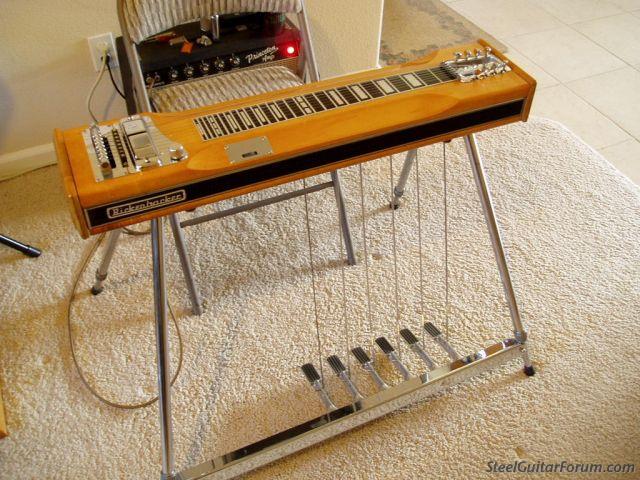
Awesome Palm
“Muting” Technique at Bridge
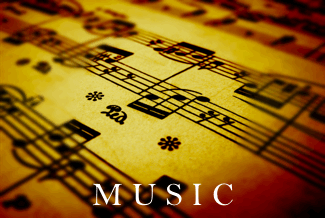
IF YOU'RE NOT USING THE MUTING
TECHNIQUE ON A REGULAR BASIS, THEN YOU'RE MISSING HAWAIIAN STEEL GUITAR
COMPLETELY.
I have recorded numerous songs
with my $79 Artisan lapsteel (now
sold by Rogue and others), which I enjoy playing because
there is nothing covering the bridge, which allows me to mute the strings
easily. I use the muting technique quite a bit in Hawaiian playing. You
simply place the palm of your right hand near the bridge, and it
mutes the strings. It is a really great sound and always surprises people
when they hear it.
Here's Kayton Roberts
using this technique in the song, Little Brown Gal.
There are several brands of
lapsteels being sold today that place a steel plate over the bridge,
preventing the player from muting the strings. It's because you've got
people building lapsteels who don't play them. You'll also see
Kayton Roberts in the
video doing some nifty tone swells with his left-hand on the tone knob.
To do this technique, you slide the bar up into the desired chord while
turning the tone control to bright at the same time. Then back off with the
bar while turning the tone control to muddy at the same time. You do this
quickly a few times and that's the effect. Nice!
On
My Yellow Ginger Lei and
The Hukilau Song
I played steel guitar accompaniment. You can download
My Yellow Ginger Lei
and
The Hukilau Song
here. You can hear me demonstrating the awesome
palm muting technique in The Hukilau Song. Not enough steel
players use this awesome technique these days. It is 100% Hawaiian! You need
this technique to play Hawaiian War Chant and The Hukilau Song
correctly. It's simple to do... you just place the palm of your right hand
at the guitar bridge. Then pick while your hand is muting the strings. Some
guitars are built by people who don't
know about this technique, so they place a chrome cover
over the bridge, thus preventing palm muting. Ironically, the cheap
$99 Rogue
lap steel is built properly.
A Great Lap Steel
for An Affordable Price
Here's a fantastic lap steel at an affordable price. I own the red one
(I think it matches the gig bag best) and it sounds awesome. It has felt
glued underside to keep it from slipping off your lap. Strings mount through
the body. The sustain is awesome. Note: I removed the chrome plate over the
bridge so I could do palm muting. I highly recommend that you do the same.
There's just 2 Philip's screws to remove. The pickup is chrome anyway, so
you don't need the cover. It looks very nice without the cover and feels
much more comfortable being able to place your hand over the bridge or close
to it. That chrome plate is terrible.
I left the round wound strings on
the guitar that came with it and they sound great; but note that the 6th
string is about .065" and won't tune up to C# (C6th + A7th) without likely
breaking.
Bar Bouncing, Tone and Volume Swells
Here's
Buddy Merrill perfectly demonstrating some bar bouncing and great tone
control knob swells. If this kid can play this good at age 15, then
anyone can learn to play steel guitar if they apply themselves.
Here's more Buddy,
doing some great tone swell technique. You can see in the video where
Lawrence Welk required for the "Fender" logo to be covered over. No
company's name was promoted if they didn't pay to be advertised on the
Lawrence Welk Show.
Don't be afraid to try new things
on your steel. You can see Lawrence Welk telling Buddy to smile for the
audience while playing. Considering all the things going on around him, it's
amazing that Buddy plays so flawlessly. You can learn a lot from this video.
Don't shy away from the strings. As you can see, Buddy Merrill takes control
of the strings. It's kind of like driving a car, i.e., either you control
the car, or else the car controls you. Pulsating the volume knob quickly
with the left-hand is used to make violin sounds on the steel guitar. Using
the tone knob produces swells like Buddy Merrill is performing in this
classic video.
Here's
Alvino Rey, a truly
amazing musician, playing the song HINDUSTAN, from his
steel guitar instrumental album, PING PONG. Alvino makes his
steel guitar sound like a muted horn, by using the same technique that Buddy
uses, but playing only one note. Alvino also uses more hand and bar movement
to achieve the desired effect. These are amazing videos that are worth a
thousand words to the steel guitar student. Very few players today are able
to perform these techniques. They have been lost over the decades. No steel
guitar course that I know of teaches how to do these techniques. We are
fortunate to have these videos to learn from. Anyone can play steel guitar;
but a true musician is also an entertainer and can amuse the audience with
various techniques, such as the ones you've seen demonstrated in these
classic videos. I like making train sounds, which is nothing more than a
diminished chord and some volume pedal swells. You slide the bar into the
diminished chord while pressing down on the volume pedal.
You can also see Alvino Rey doing
some back-raking with his picks. I use this technique much on my Hawaiian
album that I recorded for my mother in 2001 before she died later in the
year.
Here's an amazing little piece by
the famous steel guitarist, Sol Hoopii, which he called
THE TRAIN SONG.
It is a variation of the Gospel song, Life's Railway to Heaven. He
makes a train whistling sound just as I said, with volume swells and a
diminished chord. Sol Hoopii makes the sound of cows, chickens, a train
whistle, pigs, and a steam engine in the song.
C# or You'll Bb
C# or you'll Bb is just a cute
saying I heard many years ago. I never thought I'd be using C# and Bb as my
primary tunings on C6th. It's a pretty neat way to remember your tuning
options for the 6th string. A Bb is fine for C13. The C6th lap steel is
standard tuned to straight C6th (trebly to bass: E - C - A - G - E - C). By
raising the 6th string from C to C# you have a nice A7th chord on strings
3,4,5 and 6. By lowering the 6th string down to a Bb you have a C13th tuning
strummed all the way across (or just a few strings. I generally play strings
3,4,5 and 6 for a C13th). I like Bb and C# and it's hard to choose which one
I like better, and of course I like just leaving the 6th string at C for a
full C6th chord. I have tabs for Beyond The Reef using
Bb and
C# so you can see the difference how
they are used.
Playing Harmonics
 Jerry
Byrd taught that harmonics say, “I have a secret!” Harmonics are beautiful.
Most steel guitarists avoid playing harmonics because they scare themselves,
thinking they can't do it; but if you'll think ahead just a little bit while
you're playing, then you can play accurate harmonics. The trick is to make
sure your right palm is directly over the proper fret (usually 12-frets
higher than where the bar is resting). You can also play harmonics by
placing the palm (or a finger) 5 or 7 frets higher than the rot bar
position. There are known as ARTIFICIAL harmonics.
Jerry
Byrd taught that harmonics say, “I have a secret!” Harmonics are beautiful.
Most steel guitarists avoid playing harmonics because they scare themselves,
thinking they can't do it; but if you'll think ahead just a little bit while
you're playing, then you can play accurate harmonics. The trick is to make
sure your right palm is directly over the proper fret (usually 12-frets
higher than where the bar is resting). You can also play harmonics by
placing the palm (or a finger) 5 or 7 frets higher than the rot bar
position. There are known as ARTIFICIAL harmonics.
NATURAL harmonics
occur only with the strings open, at the 5th, 7th and 12-frets (and also at
the 16th, 19th and 24th frets). Yes, at the 16th and 19th frets. Try it and
you'll see! Just place your left hand's pinky finger gently on the string
and then pick it with your right hand (or you can rake across the strings
while picking them). This is called a chime, a natural harmonic! Natural
harmonics work great in the song, WHEN THEY RING THOSE GOLDEN BELLS.
On the E9th pedal steel, I play a verse and chorus once through in the key
of Eb and then modulate up to the key of E, which allows me to play the
harmony using natural harmonics.
On the C6th lap steel, songs such
as KEWALO CHIMES are composed entirely of natural harmonics.
You can here this song on Jerry Byrd's album, HAWAIIAN SUNSET. Here's
a short clip of KEWALO CHIMES
(MP3). These are all natural harmonics played by using the pinky
finger of the left hand on frets 5,7 and 12. The song is not difficult to
play, it just requires patience to learn the song. The trick to playing good
natural harmonics is to pick the strings closer to the bridge for frets 7
and 5 (especially fret 5 natural harmonics).
I've heard that harmonics are
harder on the Fender guitars, but I've never had a Fender.
Leonard T. Zinn sure makes his Fender
sound nice. I have a 1936 Rickenbacher (also called “Rickys”) and the
sustain is MUCH longer than on my $79 Artisan lapsteel I had started
learning on. I couldn't believe the difference. If you've never played a
Rickenbacher (pre WWII models are spelled with an h; whereas
post WWII Rickys are spelled with a k... "Rickenbacker"), then
you have a treat awaiting you my friend if you ever have the opportunity to
play one. On the Rickys, the tone is incredible due to the horseshoe pickups
and the dense Bakelite body; but stay away from any guitars that have had
the volume and/or tone pot swapped out. It ruins the sound completely and
there's nothing you can do about it except to find old spare parts... good
luck!
I recently bought a great used S-8
lap steel that was built with gorgeous canary wood from South America. The
guitar has a Jerry Wallace pole pickup in it, and the sustain is some of the
best I've heard. It's awesome. You can hear me attempting to play some of
Jerry Byrd's awesome harmonics from the terrific song...
SONG OF THE ISLANDS!
A lot of students of the steel
guitar become quickly frustrated when they go to tackle harmonics, and get
tackled instead, buried upon a pile of missed notes. They think at that
point that harmonics is too difficult to learn, and will require too much
work, so they give up on the harmonics. The problem is that they don't
understand the proper techniques of great harmonics. If they could get great
harmonics in their playing, then they'd love playing harmonic chimes and use
them extensively I assure you. Playing harmonics needs to become as natural
as breathing for the steel guitarist.
The 2 things that you need to do
is:
-
KNOW WHAT YOU WANT TO PLAY.
Practice in advance what you want to play with harmonics (usually the
melody line). Even if you can play great harmonics, it won't help you if
you aren't sure where to place your hand next (and that creates mental
obstacles to make you trip and stumble in your playing). That's not good
at all. So we want to become familiar enough with a song and it's
melody, so we know exactly what we want to play.
-
PLAY IT EXACT. You must
place the palm of your right hand over the fret to be chimed. Being off
even a little bit will result in either a missed chime altogether, or no
sustain because you didn't strike the string hard enough. You don't want
to pick too hard, but just hard enough to get a nice solid chime (and
then raise up the volume pedal to make the best of your chimed note
while it rings out it's life). This is equally important. Finger chimes
are much easier, because you can see what's going on; but you can't see
under your palm. So it's easy to be off by a fret, especially higher up
on the fretboard. Practice makes perfect.
I used to have a hard time with
harmonics, because I didn't have my palm exactly over the note that I had
chimed. It's much easier to place your hand accurately when you know in
advance exactly where and when to put it down on a particular fret. This is
the reason why point number 1 is so important above. If you know your song,
then you won't waste those critical milliseconds in panic trying to find the
correct place to put your hand.
Of course, seasoned musicians who
know their instruments inside and out, backward and forth, can play adlib on
a dime and execute superb harmonics nearly all the time. I'm still working
at it. I don't claim to be an expert on harmonics, but Jerry Byrd certainly
was. I learned from Jerry to THINK AHEAD a little bit in the song, to
anticipate and plan your chimes.
Here's BALI HAI, in which I play
some nice harmonics. They're not hard to do; it just takes work to get them
right. It's easy to chime a note; but it's harder when you're chiming a
melody line. I knew exactly where I was going start my first note, and made
sure to place my right palm exactly over the 10th fret where I begin at 1:29
in the video...
 People
often ask, what's that instrument you're playing called. I tell them it is a
“lap
steel guitar” or a “pedal
steel guitar,” depending on which I take to the beach. Both are unique
and beautiful and Hawaiian music can be played equally beautiful on both
instruments.
People
often ask, what's that instrument you're playing called. I tell them it is a
“lap
steel guitar” or a “pedal
steel guitar,” depending on which I take to the beach. Both are unique
and beautiful and Hawaiian music can be played equally beautiful on both
instruments. 


 Jerry
Byrd taught that harmonics say, “I have a secret!” Harmonics are beautiful.
Most steel guitarists avoid playing harmonics because they scare themselves,
thinking they can't do it; but if you'll think ahead just a little bit while
you're playing, then you can play accurate harmonics. The trick is to make
sure your right palm is directly over the proper fret (usually 12-frets
higher than where the bar is resting). You can also play harmonics by
placing the palm (or a finger) 5 or 7 frets higher than the rot bar
position. There are known as ARTIFICIAL harmonics.
Jerry
Byrd taught that harmonics say, “I have a secret!” Harmonics are beautiful.
Most steel guitarists avoid playing harmonics because they scare themselves,
thinking they can't do it; but if you'll think ahead just a little bit while
you're playing, then you can play accurate harmonics. The trick is to make
sure your right palm is directly over the proper fret (usually 12-frets
higher than where the bar is resting). You can also play harmonics by
placing the palm (or a finger) 5 or 7 frets higher than the rot bar
position. There are known as ARTIFICIAL harmonics. 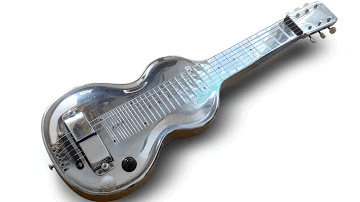 There are numerous pedal steel
tunings and setups that have been used to record some fine Hawaiian
albums.
There are numerous pedal steel
tunings and setups that have been used to record some fine Hawaiian
albums. 